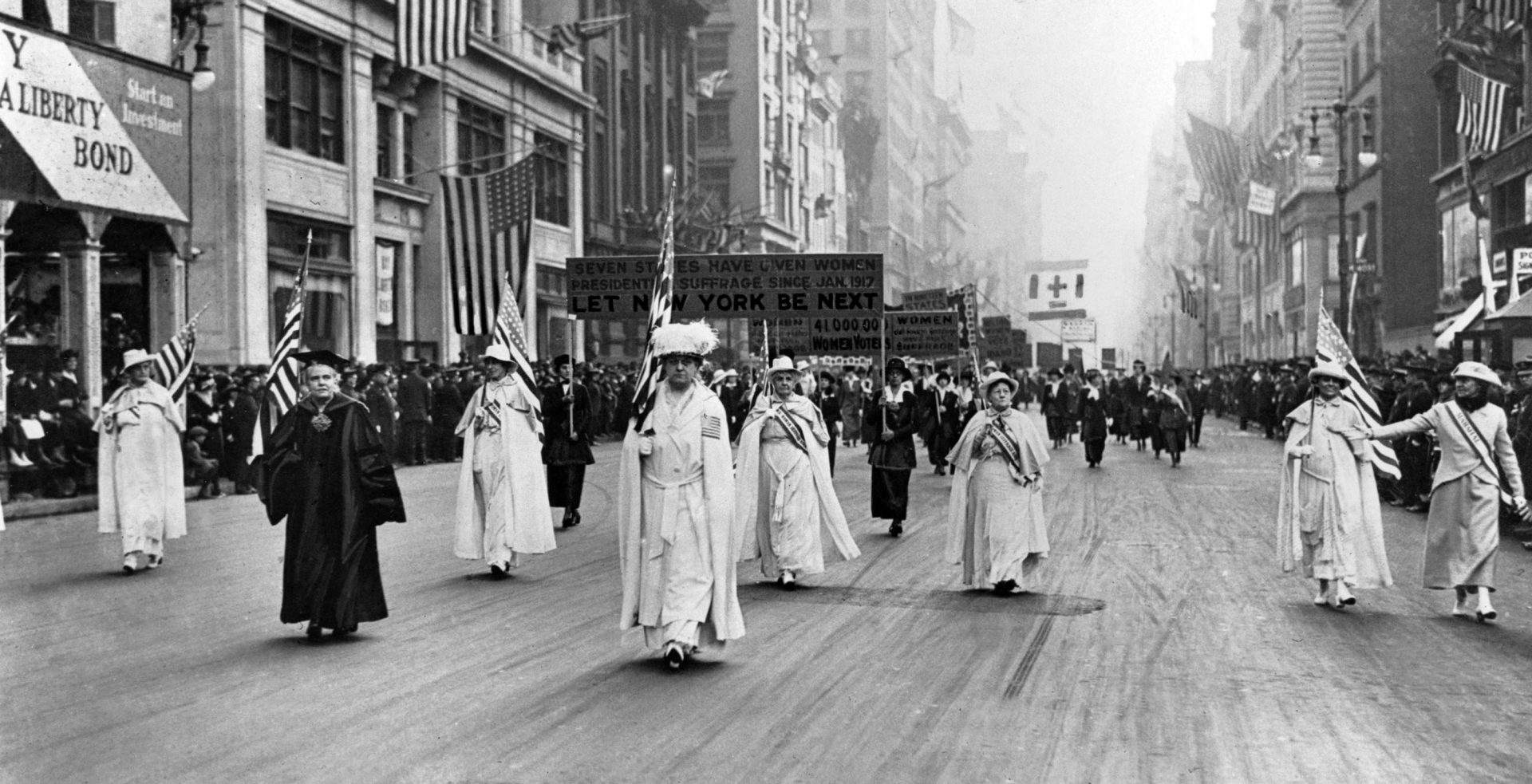
Dr. Anna Shaw and Carrie Chapman Catt, founder of the League of Women Voters, lead an estimated 20,000 supporters in a women's suffrage march on New York's Fifth Ave. in 1915.
AP Photo

Dr. Anna Shaw and Carrie Chapman Catt, founder of the League of Women Voters, lead an estimated 20,000 supporters in a women's suffrage march on New York's Fifth Ave. in 1915.
AP Photo

AP Photo
Dr. Anna Shaw and Carrie Chapman Catt, founder of the League of Women Voters, lead an estimated 20,000 supporters in a women's suffrage march on New York's Fifth Ave. in 1915.
It’s the 100 year anniversary of the ratification of the 19th Amendment, which gave women the right to vote. The commemoration of the centennial is bringing up questions about the women most closely associated with movement and those women who are not remembered.
The women’s suffrage movement is linked to promiment figures like Elizabeth Cady Stanton and Susan B. Anthony. These two women are remembered as fighting for the rights of all women. But Lori Ginzburg, the author of “Elizabeth Cady Stanton: An American Life,” says that while Cady Stanton was passionate about the suffragist movement, she did not think everyone deserved the right to vote.
“I argue in my book that [Cady Staton] was racist and elitist. She believed that her being denied and woman like her — white, middle class, protestant women — was an insult to women, whom she believed were better fit to exercise political power than foreigners and recently emancipated slaves and others who she thought were basically beneath her,” Ginzburg said.
Cathleen Cahill, an associate professor of history at Penn State, is working on a collective biography on six women of color who were suffragists. Cahill said that though the women had the same motivation, they had vastly different goals and messages they wanted to get across.
“All of the women I am talking about use suffrage to advocate women’s rights but also to open up the conversation to think about how race and gender intersect,” Cahill said.
Cahill said that when writing her first book she found an article about Marie Bottineau Baldwin. Researching Baldwin prompted Cahill to look for more women of color suffragists.
Baldwin was Turtle Mountain Chippewa and French and grew up on a reservation with her father. Baldwin began her career as a suffragist through her father when she went with him to DC.
“Her father is an attorney who moves to DC at the request of tribal leaders to fight for what they want and she goes with him and works as his law clerk,” Cahill said.
While in DC, Baldwin attended law school at the Washington College of Law, which is one of the first in the nation to allow women. The school was full of suffragists.
“And [Baldwin and her classmates] get involved in the most famous suffrage activism in D.C. at that moment which is the 1913 parade.” Cahill said.
During the 1913 parade, there were a number of African American women planning to march. However, the white organizers were hesitant to allow them to take part because they needed the support of white southerners. The African American women pushed back, especially Cary Williams Clifford, who insisted they walk in the parade.
Clifford was a writer and wrote about African American women’s experience in the parade.
“She writes articles for The Crisis, which is the magazine of the NAACP, talking about which African American women were in the parade. She names them, makes sure the historians in the future have this record of their participation. That’s really important to her,” Cahill said.
Cahill also featured Mabel Lee, a Chinese suffragist who moved to the United States with her parents when she was five. Lee spoke out against the treatment of Chinese immigrants. White American suffragists sought after Lee’s involvement in their movement because they were interested in the Chinese revolution, which supported women’s rights. Lee was invited to talk in a meeting in New York City to the top leaders of the movement.
“She uses that platform to both talk about women’s suffrage and women’s rights in China, which is what they want to hear about,” Cahill said, “but also uses the opportunity to talk about American policies toward Chinese immigrants which at the moment are the policies of exclusion.”
Cahill said these women are often overlooked because of who wrote history.
“Our story about suffrage comes from certain suffragists themselves, but they wrote it in such a way that it highlighted their story. And they really focused on people like Susan B. Anthony and Elizabeth Cady Stanton,” Cahill said.
Native Americans did not get the right to vote until after World War II and in practice Jim Crow laws kept African American men and women from voting in the south. Cahill said that this side of history is being taken into account during the centennial.
“There’s been some really fruitful historical conversations and conversations in the commemoration about what did 1920 mean and for whom. But we need to keep having that after the commemoration is over and I think we need to ask how does it change our story then?” Cahill said.
Cahill’s book, “Joining the Parade: Women of Color Challenge the Mainstream Suffrage Movement” explores six suffragists’ lives and what they did after the ratification in 1920. It will be released in Fall 2020.
This story originally appeared on WPSU.

Get insights into WITF’s newsroom and an invitation to join in the pursuit of trustworthy journalism.
The days of journalism’s one-way street of simply producing stories for the public have long been over. Now, it’s time to find better ways to interact with you and ensure we meet your high standards of what a credible media organization should be.